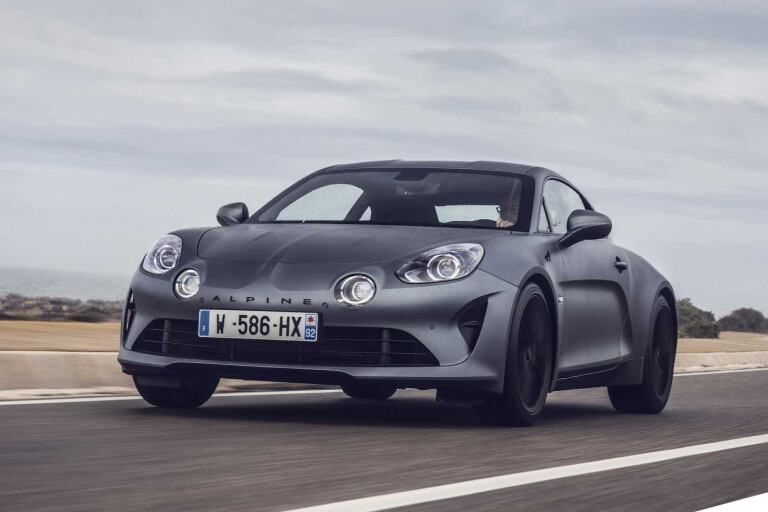
The high-speed Estoril circuit in Portugal is pure bliss for testing grown-up sports cars like the McLaren Senna, but it’s a bit of overkill for the Alpine A110, which will take some of the 13 corners dotting its 4.1km lap without even lifting the throttle. Even this latest A110S model, which gains 30kW over the base model, simply cannot muster the raw grunt to challenge the wide radii and grippy surface.
Like all new Alpines, the 2020 model is invariably crowned king of power-to-weight in its segment. Tipping the scales at a featherweight 1114kg (1108kg with carbonfibre roof and forged Fuchs alloy wheels), the ultimate Alpine has some 193kW per tonne.
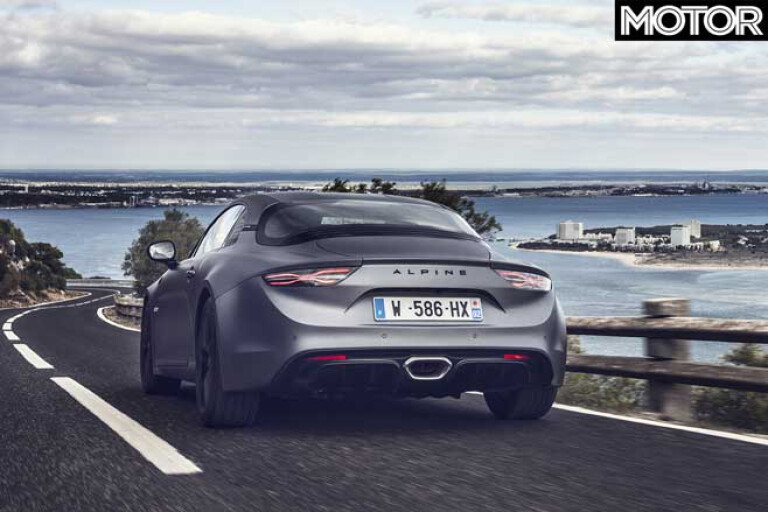
That’s why it can hurl itself from rest to 100km/h in an impressive 4.4sec, matching the 309kW Porsche Cayman GT4, which weighs some 300 kilos more. At the same time, top speed climbs from 250 to 260km/h, but perhaps the most exciting number is for the in-gear acceleration from 80-120 in third, which is over and done with in a time-warp 2.6sec. Bravo!
At the other end of the love-hate chart sits the asking price, which in Europe is a hefty 16 per cent more than the lesser-equipped 185kW base version. Expect to pay at least $110,000 for the car in Australia – about $7000 more than the more highly specified Legende version of the base model available here.
The main mechanical change concerns the uprated 1.8-litre four, which gets a higher boost pressure (up 0.4bar) and a higher redline (up 400rpm) to produce a feistier 215kW at 6400rpm. The unchanged maximum torque of 320Nm is available over a broader range, from 2000 to 6400rpm, so almost permanently in real life.
As you would expect, the engineers also did a fair bit of chassis tuning. The hollow anti-roll bars are now twice as rigid, the springs are 50 per cent stiffer, the shock absorbers tuned accordingly, and the car sits 40mm closer to the ground.

Michelin composed a new super-sticky compound for the 215/40 ZR18 and 245/40 ZR18 footwear. In addition, the Renault software specialists dialled in a more aggressive ESP setting for Track mode. Last but not least, the Sport version boasts larger-diameter Brembo disc brakes.
Even painted in this depressing gunmetal grey and without any extras, I simply love the Alpine for its airy and roomy cabin. The French contender offers more room for long limbs and necks than its German and Japanese rivals, the trim made largely of black synthetic fibres is durable and inoffensive, and the steering wheel and pedals are positioned perfectly.
Dislikes? The seats are only adjustable in reach, not in width and height, and the backrest is fixed at an odd angle. The radio is a joke – poor reception and concealed controls only a watchmaker could love – the infotainment is simply too basic for a brand-shaper, and the sub-standard headlights are unchanged from the lesser version.

The A110S is better tied down than its more humble stablemate, it rolls less, pitch and yaw are even harder to provoke, cornering grip is up a fraction, the sports exhaust sounds louder and gaudier above 4500rpm, and the brake calipers and discs communicate with enhanced enthusiasm. But these differences are frankly nuances rather than fundamental improvements.
Despite the allegedly tauter chassis software, the ride is thankfully still reasonably compliant even on lesser roads and the more direct steering is still well damped. While the stronger brakes are still easy to modulate, a bit more initial bite wouldn’t hurt.
A key dynamic asset is the seven-speed DCT, which shifts the focus one step away from efficiency and closer to excitement. And even though the drag coefficient of 0.32 was secured without the support of any visible wing work, there is enough top-speed downforce to rivet nose and tail to the ground.
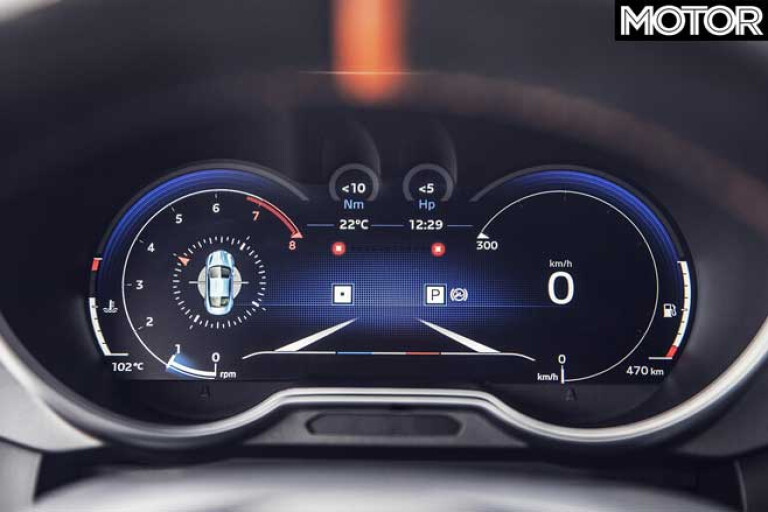
Since the essentially mass-produced engine is neither haunted by the faintest trace of turbo lag nor by the remotest unwillingness to rev, the S model puts on quite a show as soon as you floor the loud pedal.
Sport mode is where the fun starts. In this program, the steering firms up, the dampers prick their valves and the shift speed increases by a kick in the butt, but any died-in-the-wool Alpinist is ready for even more involvement. So let’s select Track mode, which turns up the spicing to vindaloo.
Twenty minutes later, even that’s not hot enough anymore, so you reach for the ESC off button, knowing full well that off means off, without a safety net. This is great on the track but for the fact that the Alpine runs out of grunt halfway through Estoril’s faster corners, which are coned off to prevent high-speed slides.
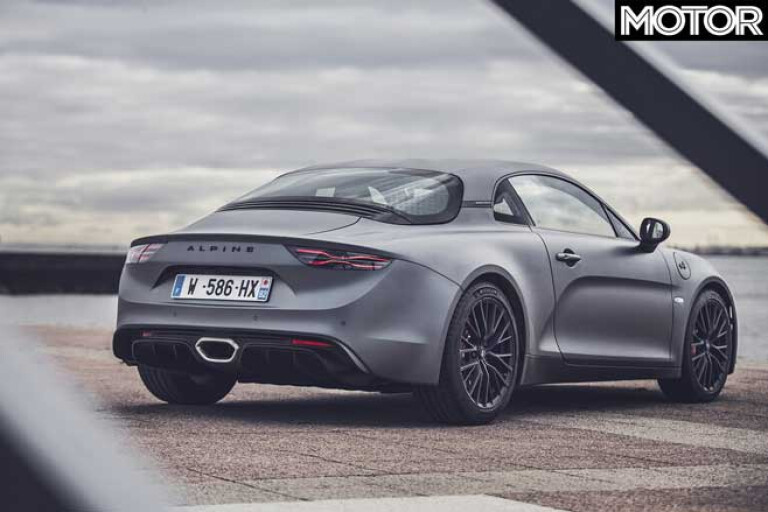
Second-gear bends, on the other hand, are hilarious. A timely downshift, a flick at the wheel paired to a stab at the throttle and the mid-engined coupe tap-dances through the Esses.
The roadholding on public roads is not nearly as tenacious, with momentary understeer, sudden tramlining, a brief shouting match between gearbox and electronic diff, short-shifting for a smoother torque transfer, snap oversteer and impromptu traction issues.
Then it starts raining and the Alpine feels like it’s travelling across an ice rink, forcing you to scale back the inputs. But with time to adjust, the angst gives way to ambition again. True, hustling from A to B is not about absolute speed anymore, it’s now about how to best maintain the flow. Since the front tyres are still hot enough to trust their turn-in grip, pressing on delicately without understeering or oversteering into trouble is the new order for the afternoon.
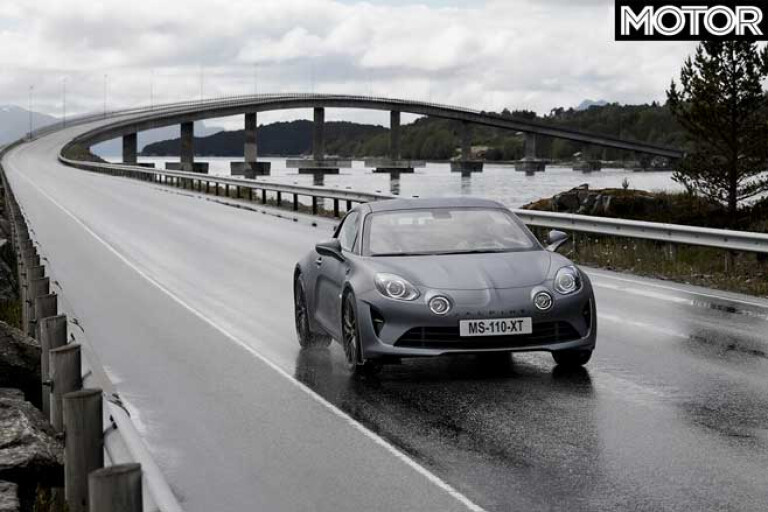
Soaked but smiling, I finish this launch drive with sizzling exhaust and smelly brakes, pondering the final verdict. Would I fork out the extra dough to be one-tenth quicker to 100km/h and 10km/h faster overall than the guy in the base model? Probably not.
While I would definitely pay a premium for the bigger brakes, you need to rev that 1.8-litre hard to 5000rpm and beyond to actually feel the extra power, which is more a matter of opportunity than inclination. I envisage a long debate raging about the chassis upgrades, which are of undisputed value on the track but much less so (and occasionally even counter-productive) on the road.
At the end of the day, trading compliance and control for cornering speed and crisper handling does not seem to be such a super deal. The good thing is that both this and the base models benefit from an awesome power-to-weight ratio no direct contender can surpass.

ALPINE A110S SPECS
Engine: 1798cc inline-4, DOHC, 16v, turbo
Power: 215kW @ 6400rpm
Torque: 320Nm @ 2000-6400rpm
Weight: 1114kg (dry)
0-100km/h: 4.4sec (claimed)
Price: $110,000 (est)
Likes: Light weight; extra power and track ability; lively response; still a great sports car
Dislikes: Looks the same; audio controls; seat backrest angle; questionable extra value
Rating: 4.5 out of 5 stars

COMMENTS